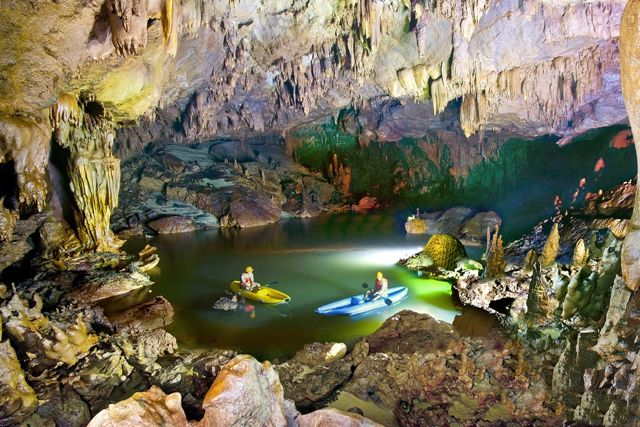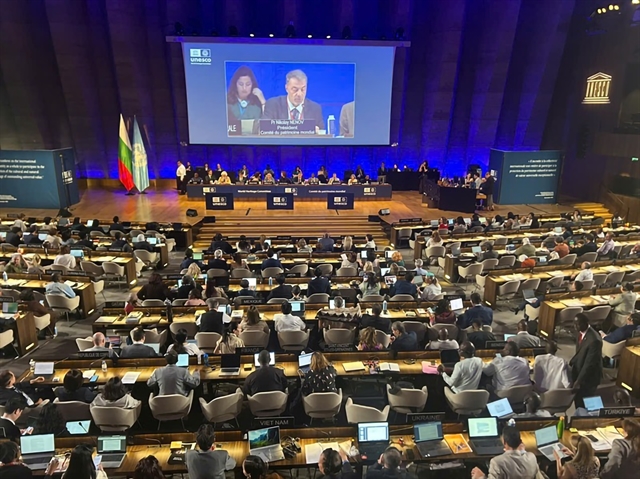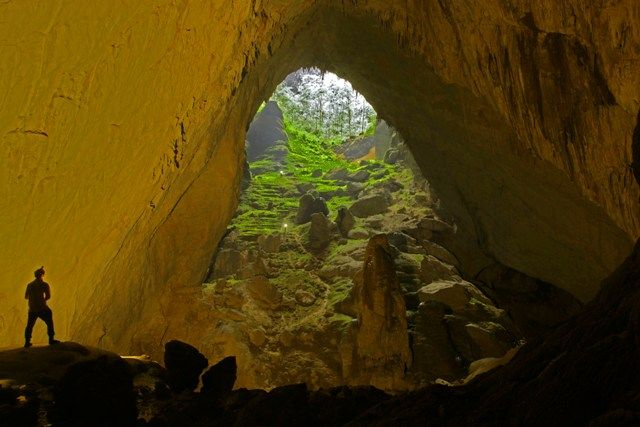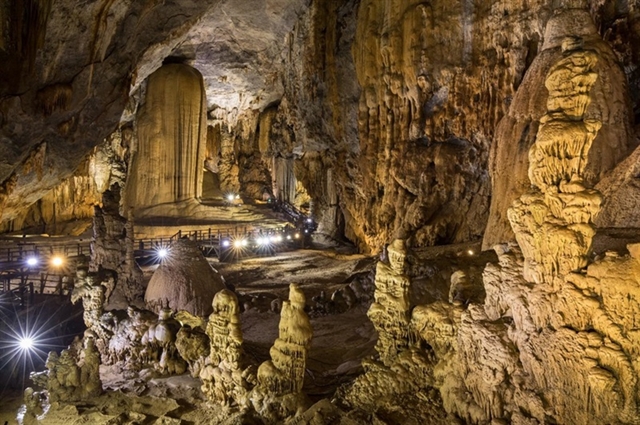Weather:
- Ha Noi 32oC
- Da Nang 30oC
- Ho Chi Minh 34oC

Mai Khuyên
"Wow, nature, how magically amazing you are!"
This is typically the first exclamation by visitors when visiting Phong Nha Kẻ Bàng National Park in the central province of Quảng Trị.
Like others in a large group of hundreds of tourists from Hà Nội, I had the same impression while taking a tour to the natural heritage.
It is no coincidence that the park, with its beautiful landscape created by a unique cave system and natural forest, has maintained its top choice for travellers to the central region of Việt Nam, particularly those who love exploring nature, embarking on adventures and conducting scientific research.
For most of the visitors in the group, it was their first time visiting the park, just a few days before the World Heritage Committee of UNESCO recognised Phong Nha Kẻ Bàng (PNKB), accompanied by Hin Nam No (HNN) Natural Park of Laos, as the first transboundary World Heritage site for the two countries.

The recognition promises more inspiration for travellers, adventurers, scientific explorers and researchers to expand their exploration of Việt Nam and Laos.
Jake Brunner, head of the Lower Mekong Subregion for the International Union for Conservation of Nature (IUCN), told Việt Nam News: "This is the first transboundary natural World Heritage Site in Asia, so it is a very significant decision. It is the culmination of many years of international support to the government of Laos with the preparation of the nomination documents."
As the statutory advisor to UNESCO on natural World Heritage sites globally, the IUCN has strongly supported the nomination of HNN because the park adds scale and diversity to PNKB, according to Brunner.

A report of PNKB National Park said that with this decision, HNN, which is naturally adjacent to PNKB, has also officially become part of the World Heritage system, possessing outstanding global values according to the criteria of geology, geomorphology, ecosystem, and biodiversity.
In particular, in terms of geology, the parks possess a unique karst system, a complex combination of limestone, shale, sandstone and granite, the report said.
The UNESCO recognition of the two parks as a new boundary heritage site resulted from a long-term cooperation between Việt Nam and Laos, starting in 2018, with a Memorandum of Understanding signed between the Ministry of Culture, Sports and Tourism of Việt Nam and the Ministry of Information, Culture and Tourism of Laos.
The MoU was followed by an agreement reached by the two governments in early 2023 on developing a dossier to nominate the two parks as a transboundary World Heritage site. The joint nomination dossier was submitted by the two governments of Việt Nam and Laos to UNESCO in February 2024.

Attending the 47th Session of the WHCU held in Paris in July, Hoàng Xuân Tân, vice chairman of the People's Commitee of the then Quảng Bình Province (now part of Quảng Trị Province), said that PNKB had actively supported Lao friends in preparing the dossier.
"The two national parks are located next to each other, so in the near future, their management work in the process of conservation and development will be carried out most synchronously and effectively," Tân said.
The two parties will apply separate parallel management mechanisms, including a strategic management plan for PNKB and a management plan for HNN, but still closely coordinate in areas such as law enforcement, scientific research, community education, sustainable livelihood development and tourism capacity control, according to Tân.
The UNESCO recognition not only holds significant meaning in conservation but also opens up numerous prospects for sustainable tourism development, thereby improving the livelihoods of local communities in the border areas.

Support and standards
Along with coordinating and providing support for HNN National Park to build and submit a dossier for recognition as a transboundary World Heritage site, PNKB National Park has made continuous efforts to preserve nature and biodiversity in line with the Green List standards.
The Green List is a global initiative by the IUCN that identifies and promotes protected and conserved areas effectively and equitably, thereby achieving their conservation goals and serving as a benchmark for success in nature conservation.
The IUCN advises UNESCO on natural World Heritage Sites and as HNN has become a transnational extension, special attention will be paid on how the PNKB and HNN parks will work together to ensure effective management across the 220,000-hectare landscape.
Brunner explained: "As we’ve seen from the Vietnamese experience, such a designation drives up tourism, which generates revenue and jobs. But if poorly managed, it can represent a serious threat to the site’s outstanding universal values. Very few tourists visit HNN."

A key way that Việt Nam could assist Laos would be to open up the Ca Roong border crossing to tourists from Việt Nam and Laos, and eventually all international tourists, he recommended.
"Access to HNN is much easier from Phong Nha [in Việt Nam] than it is from Thakhek [Laos]. Also important is that tourism to the major caves in PNKB prioritises low volume/high value to minimise environmental impact in line with World Heritage Site guidelines – and generates substantial local employment," he added.
According to Đinh Huy Trí, deputy director of PNKB National Park Management Board, PNKB is the only national park in Việt Nam to be twice recognised by UNESCO as a World Heritage site. It has become the first such site in Southeast Asia to meet three out of four criteria.
"With its existing and potential global outstanding values, Việt Nam will continue to submit to UNESCO for a third-time recognition as a World Heritage Site on aesthetic criteria; and at the same time, strive to achieve Green List certification," Trí told the Nhân Dân (The People) newspaper.
Since 2017, GIZ Laos has supported cooperation between Laos and Việt Nam on nature conservation, and since 2021, the IUCN and GIZ have also supported the application of the IUCN Green List Standard for Protected and Conserved Areas in HNN and PNKB.

The PNKB and HNN national parks possess a system of more than 220km of caves and underground rivers, such as Sơn Đoòng in Việt Nam and Xe Bang Fai in Laos. It is the evidence of a geomorphological process lasting millions of years.
In terms of biology, this area is home to more than 2,700 species of vascular plants and more than 800 species of vertebrates.
HNN alone has recorded more than 1,500 plant and 536 vertebrate species, including many rare and endemic species, such as the giant huntsman spider – the world’s largest spider, found only in Khammouane Province of Laos. The area is also home to 10–11 primate species, including the largest remaining population of the southern white-cheeked gibbon and black langur.

Touring Paradise Cave
During our tour of PNKB, provided by Viettravel in mid-July, we chose to stop first at Động Thiên Đường (Paradise Cave) and then proceeded to a few more stops at local tourist spots along the way.
To reach the destination, we had to conquer the 500-step stone staircase that leads up to the entrance of the cave. During our climb, we had the chance to enjoy lush green trees and foliage, with the sounds of chirping birds and the gentle rustling of leaves.
The stairway itself is well-preserved and designed to be safe and easy to climb up, with sturdy handrails and lighting for those exploring during the evening. The climb takes about 30 minutes on average. There are also plenty of resting places along the way.
Passing through the entrance, a narrow gap between large rocks stacked on top of each other, and enough only for one or two persons, we walked across a wooden path and started to enjoy majestic scenes like those found in a movie.
The cave was a secret of nature in the heart of the PNKB until 2005, when local Hồ Khanh was the first to discover it. Khanh then became a navigator for the British Royal Cave Association expedition to explore the location further.
The cave is worthy of being called a paradise due to its magnificent and incredible formations. It possesses breathtaking beauty that resembles a heavenly paradise on earth, making it one of the most stunning natural wonders anywhere.
Contrary to the hot weather outside, which stood at over 34 degrees Celsius on the day we arrived, walking deeper into the cave, the air becomes cooler. The average temperature inside is often around 16C.
The pathways within the cave are also well-maintained, making it accessible to people of all ages. From the small entrance, we reached a spacious area, approximately 15m in length, surrounded by numerous stalactites.
However, once reaching the main cave, we encountered an incredibly vast space with a width of up to 150m.

All visitors in our group were impressed with the large stone blocks and systems of stalactites formed in various pillars and images of animals and humans, some of which are even high enough to connect the bottom and the cave dome. Many images inside the cave were recorded like watercolour paintings.
Phan Thu Hằng from Hà Nội, who has been to Động Thiên Đường a few times, said that each time she returned, she had new passion and imagination, but still did not feel satisfied, wondering how tectonic waves have occurred over thousands of years, and how the stalactites that look like jade rabbits or elephants are naturally formed.
"There are scenes that when I pass by, I find so beautiful that I keep taking pictures again and again, when I come back and feel them with my imagination, I see many beautiful sketches like legends," she said.
Paradise Cave is more than 31km long and 60-100m high, making it one of the longest dry caves in Asia. It is naturally adorned with a vast array of exquisite stalactites and stalagmites, which have been formed over thousands of years.
Visitors can also unwind under a skylight in the cave that allows sun rays to filter through. The natural lighting in Paradise Cave creates such a fascinating interplay of light and shadow that visitors often feel as though they are in a different world.
The lighting system guiding visitors through the cave is also a delicate arrangement. Unlike in some other underground destinations that often use colourful lighting systems to create an illusion, the lighting system along the 1km path in Paradise Cave is all white light, showing the original colour of the stalactites inside. VNS

